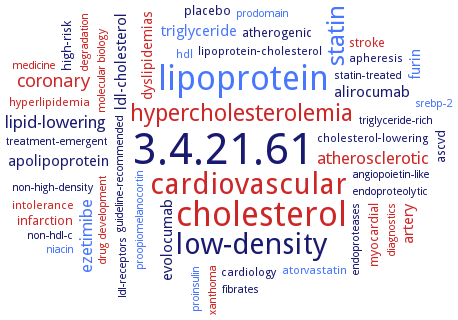3.4.21.61: Kexin
This is an abbreviated version!
For detailed information about Kexin, go to the full flat file.

Word Map on EC 3.4.21.61 
-
3.4.21.61
-
cholesterol
-
lipoprotein
-
cardiovascular
-
low-density
-
statin
-
hypercholesterolemia
-
coronary
-
lipid-lowering
-
atherosclerotic
-
ezetimibe
-
evolocumab
-
alirocumab
-
furin
-
artery
-
apolipoprotein
-
triglyceride
-
ldl-cholesterol
-
dyslipidemias
-
myocardial
-
placebo
-
stroke
-
high-risk
-
ascvd
-
infarction
-
atherogenic
-
hyperlipidemia
-
atorvastatin
-
cholesterol-lowering
-
intolerance
-
lipoprotein-cholesterol
-
hdl
-
cardiology
-
apheresis
-
diagnostics
-
non-high-density
-
ldl-receptors
-
angiopoietin-like
-
proinsulin
-
proopiomelanocortin
-
treatment-emergent
-
srebp-2
-
endoproteolytic
-
guideline-recommended
-
triglyceride-rich
-
drug development
-
prodomain
-
endoproteases
-
degradation
-
non-hdl-c
-
fibrates
-
xanthoma
-
statin-treated
-
molecular biology
-
medicine
-
niacin
- 3.4.21.61
- cholesterol
- lipoprotein
- cardiovascular
-
low-density
- statin
- hypercholesterolemia
- coronary
-
lipid-lowering
- atherosclerotic
- ezetimibe
-
evolocumab
-
alirocumab
- furin
- artery
-
apolipoprotein
- triglyceride
-
ldl-cholesterol
- dyslipidemias
- myocardial
-
placebo
- stroke
-
high-risk
-
ascvd
- infarction
-
atherogenic
- hyperlipidemia
- atorvastatin
-
cholesterol-lowering
- intolerance
-
lipoprotein-cholesterol
- hdl
-
cardiology
-
apheresis
- diagnostics
-
non-high-density
-
ldl-receptors
-
angiopoietin-like
- proinsulin
- proopiomelanocortin
-
treatment-emergent
- srebp-2
-
endoproteolytic
-
guideline-recommended
-
triglyceride-rich
- drug development
- prodomain
- endoproteases
- degradation
-
non-hdl-c
-
fibrates
- xanthoma
-
statin-treated
- molecular biology
- medicine
- niacin
Reaction
Cleavage of -Lys-Arg-/- and -Arg-Arg-/- bonds to process yeast alpha-factor pheromone and killer toxin precursors =
Synonyms
adrenorphin-Gly-generating enzyme, ASP, BLI-4, corin activating enzyme, EC 3.4.22.23, endoproteinase Kex2p, Gene KEX2 dibasic proteinase, HuPCSK6, Kex 2p proteinase, Kex2, Kex2 endopeptidase, Kex2 endoprotease, Kex2 endoproteinase, Kex2 protease, Kex2 proteinase, Kex2-660, Kex2-like endoproteinase, Kex2-like precursor protein processing endoprotease, Kex2p, kexin, More, NARC-1, Paired-basic endopeptidase, PC 1/3, PC1, PC1/3, PC2, PCSK type 9, PCSK6, PCSK9, plasma proprotein convertase subtilisin-kexin type 9, pro-protein convertase subtilisin/kexin type 9, prohormone convertase 1, prohormone convertase 1/3, prohormone convertase 2, prohormone processing protease, Prohormone-processing endoprotease, Prohormone-processing KEX2 proteinase, Prohormone-processing proteinase, Proprotein convertase, proprotein convertase 1/3, proprotein convertase Kex2, proprotein convertase subtilisin kexin type 9, proprotein convertase subtilisin kexin-9, proprotein convertase subtilisin-like/kexin type 9, proprotein convertase subtilisin/kexin 6, proprotein convertase subtilisin/kexin type 6, proprotein convertase subtilisin/kexin type 9, proprotein convertase subtilisin/kexin type 9 (PCSK9)Proprotein convertase subtilisin/kexin type 9, proprotein processing protease, Protease KEX2, Proteinase Kex2p, Proteinase yscF, Proteinase, prohormone-processing, Yeast KEX2 protease


 results (
results ( results (
results ( top
top





